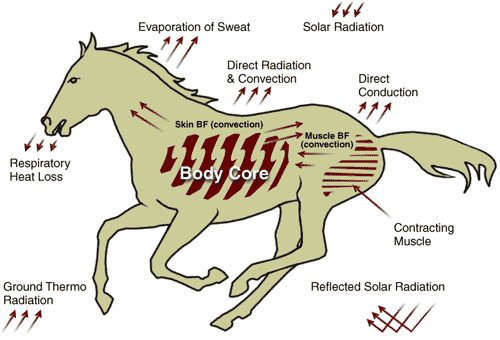Equine Thermoregulation
April 02 2016 – Greg Wood

How Do Horses Stay Cool During Work and Exercise?
Thermoregulatory mechanisms in the horse are very important during exercise and work. Heat production occurs with the metabolism of fuels for exercise.
Thoroughbred racehorses produce enough heat to increase their body temperature 3.25º C to 5.42º C. As in human athletes, the equine athlete’s thermoregulatory system utilizes convection, radiation, respiratory losses, and evaporation to remove heat from the body.
Evaporation includes the removal of heat through sweat.
The cardiovascular system plays an important role in transferring heat from the sites of production, such as the muscles, to sites where dissipation can occur, such as the skin.
During exercise, blood flow to the skin increases in order for evaporation of sweat to occur. The amount of heat dissipated by 1 liter of sweat is equivalent to one to two minutes of high intensity exercise or five to six minutes of submaximal endurance exercise.
Although horses do not normally pant, the respiratory tract is able to dissipate heat through air exchange. Convection and radiation are the direct transfer of heat from the skin to the environment.
Authors: Craig Wood, University of Kentucky; Ashley Griffin, University of Kentucky
